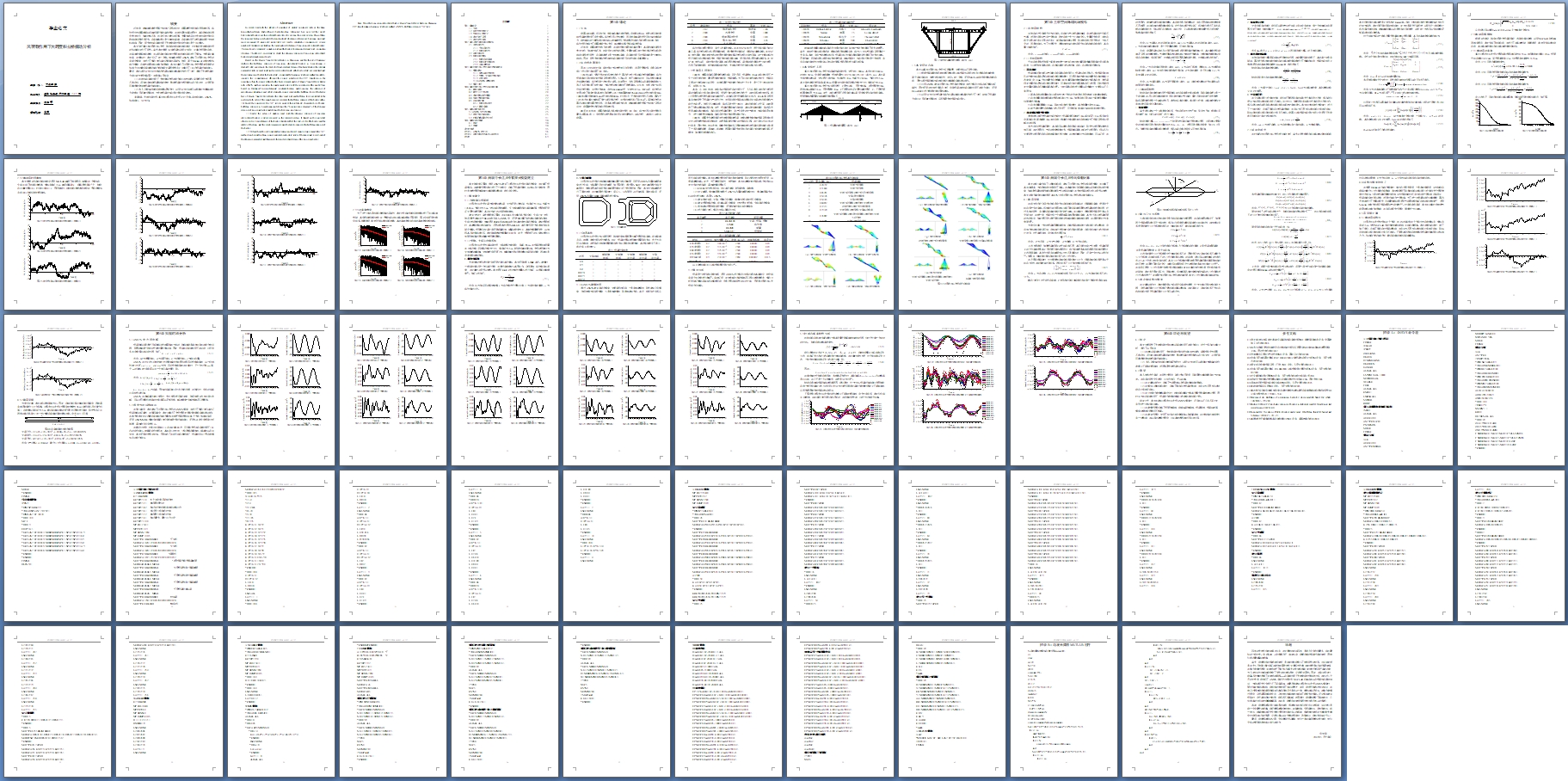风荷载作用下大跨度斜拉桥振动分析

风荷载作用下大跨度斜拉桥振动分析(开题报告,外文翻译,论文15000字)
摘要
近年来,随着港珠澳大桥等一批世纪工程的问世,我国建桥技术如今已领跑世界。斜拉桥作为我国跨越江河海洋等天堑的首选桥型,在跨径屡创新高的同时,其风致振动问题也愈发突出,如若控制不当,将会引发灾难性的后果。大量文献正在对大跨径斜拉桥的风致振动问题进行研究。风荷载本质上是一种随机荷载,风荷载作用下的桥梁振动是一种随机振动。因此,研究随机风荷载作用下大跨度斜拉桥的动力响应是十分必要的。
本文依托重庆市白居寺长江大桥,结合谐波合成法相关理论,对时域内大跨度斜拉桥的抖振响应进行了研究。首先本文根据《公路桥梁抗风设计规范》,计算出桥面处风速、功率谱密度等相关参数,并运用谐波合成法对桥面处的脉动风场进行了模拟。为提高计算效率,在模拟时,本文引入了FFT变换。接着本文利用ANSYS建立了白居寺长江大桥的有限元模型,并进行了模态分析以验证模型的正确性。然后,基于Davenport的准定常抖振力模型,忽略气动导纳与自激力的影响,本文计算出了白居寺长江大桥桥面处所承受的抖振力,并将静风荷载和抖振力添加到主梁两侧节点上,计算出了10s内桥梁的抖振响应。最后,本文运用“ ”法则对时域内桥梁抖振响应概率特性进行了分析,得到了大跨桥梁动力响应的“时程包络图”,并得到以下结论:
[资料来源:Doc163.com]
(1)在随机风荷载作用下,大跨度斜拉桥的动力响应较为剧烈,沿横桥向尤为明显,不容忽视,否则将会造成桥梁结构的疲劳,影响桥梁的使用寿命以及行车安全,必须采取可靠措施来抑制桥梁的抖振响应。
(2)当人工模拟的脉动风速样本足够大时,运用“ ”法则就可以得到较为精确的动力参数上下限值时程曲线,为大跨桥梁的抗风设计提供些许参考。
关键词:大跨径斜拉桥;重庆市白居寺长江大桥;FFT变换;谐波合成法;ANSYS;抖振响应;“ ”法则。
Abstract
In recent years,with the advent of a number of century signatories such as the Hong Kong-Zhuhai-Macao Bridge,China's bridge-building technology has now led the world. Cable-stayed bridges are the preferred bridge type for crossing the great rivers in China. When the spans are hitting new heights,the wind-induced vibration problems are becoming more and more prominent. If improperly controlled,it will lead to catastrophic consequences. A large number of literatures are studying the wind-induced vibration of long-span cable-stayed bridges. The wind load is essentially a random load,and the bridge vibration under wind load is a random vibration. Therefore,it is necessary to study the dynamic response of long-span cable-stayed bridges under random wind loads.
Based on the Baijusi Yangtze River Bridge in Chongqing and the theory of harmonic synthesis,the buffeting response of long-span cable-stayed bridges in time domain is studied.Firstly,according to the Code for Wind-resistant Design of Highway Bridges,the relevant parameters such as wind speed and power spectral density at the bridge deck are calculated, and the pulsating wind field at the bridge deck is simulated by harmonic synthesis method.In order to improve the computational efficiency,this paper introduces the FFT transform in the simulation.Then this paper establishes the finite element model of Baijusi Yangtze River Bridge with ANSYS, and has carried on the modal analysis to verify the correctness of the model.Then, based on Davenport's quasi-stationary constant-vibration model,ignoring the influence of aerodynamic admittance and self-excitation,this paper calculates the buffeting force of the bridge face of Baijusi Yangtze River Bridge.the static wind load and buffeting force are added to the nodes on both sides of the main beam. we calculate the buffeting response of the bridge within 10s.Finally,this paper uses the " " rule to analyze the probability characteristics of bridge buffeting response in time domain,and obtains the "time envelope diagram" of the dynamic response of long-span bridges,and obtains the following conclusions:
[资料来源:Doc163.com]
(1)Under the action of random wind loads,the dynamic response of long-span cable-stayed bridges is severe,especially in the lateral direction. It should not be neglected, otherwise it will cause fatigue of the bridge structure,affect the service life of the bridge and the safety of the train. and the reliable measures must be take to suppress the buffetingresponse of the bridge.
(2)When the artificially simulated pulsating wind speed sample is large enough,the “ ” method can be used to obtain a more accurate time-history curve of the upper and lower limits of the dynamic parameters,and then guide the wind-resistant design of the long-span bridge.
Key Words: Long-span cable-stayed bridge; Baijusi Yangtze River Bridge in Chongqing; FFT transformation; harmonic synthesis method; ANSYS; Buffeting response; “ ” rule.
[资料来源:www.doc163.com]

目录
第1章绪论 1
1.1 引言 1
1.2 斜拉桥发展简介 1
1.3 桥梁风工程简介 2
1.4 本文依托工程 3
1.5 本文研究内容 4
第2章三维空间脉动风场模拟 5
2.1 自然风特性 5
2.1.1 平均风特性 5
2.1.2 脉动风特性 6
2.2 谐波合成法 7
2.3 脉动风场模拟 9
2.3.1 脉动风功率谱 9
2.3.2 脉动风时程曲线 10
2.3.3 功率谱检验 13
第3章白居寺长江大桥有限元模型建立 14
3.1 模型建立 14
3.1.1 钢桁梁与桥面板 14
3.1.2 桥墩、主塔与拉索系统 14
3.1.3 边界条件 15
3.1.4 ANSYS建模流程 15
3.2 模态分析 16
第4章白居寺长江大桥风荷载计算 19
4.1 静风荷载 19
4.2 静力三分力系数 20
4.3 准定常抖振力模型 20
4.4 抖振力模型的修正 22
4.5 风荷载计算 22
4.5.1 脉动风抖振力 22
4.5.2 静风荷载 24
第5章抖振时域分析 25
5.1 ANSYS中方程求解 25
5.2 跨中节点抖振响应 25
5.3 时域内概率特性分析 31
第6章结论与展望 34
6.1 结论 34
6.2 展望 34
参考文献 35
附录1:ANSYS命令流 36
附录2:谐波合成法MATLAB程序 61
致谢 63 [资料来源:http://Doc163.com]
